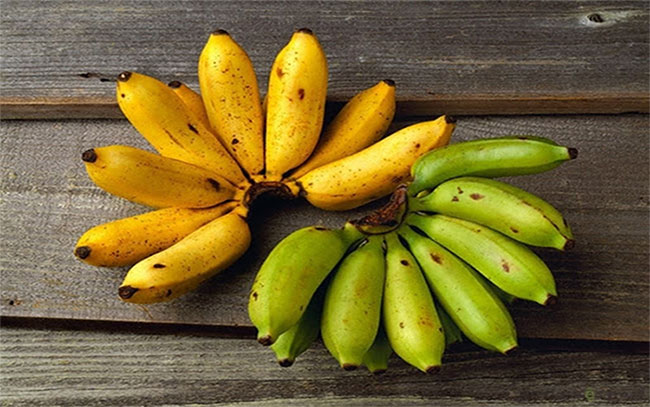Green and yellow bananas: what’s the difference?
Bananas are usually harvested while they are still green. This is to make sure that they don’t overripe before buying. Therefore, you can see them in this color at the supermarket.
In addition to the different colors, green and yellow bananas also differ in some ways:
Additionally, green bananas are harder to peel, while ripe bananas are easy to peel.
 Unripe bananas mainly contain starch.
Unripe bananas mainly contain starch.
When a banana is ripe, its carbohydrate content changes
Unripe bananas contain mostly starch, accounting for 70-80% of their dry weight. Most of these starches are resistant starch which is not digested in the small intestine. Therefore, it is often classified as a dietary fiber.
However, bananas lose their starch as they ripen. During maturation, their starch is transformed into simple sugars (sucrose, glucose and fructose). Interestingly, ripe bananas contain only 1% starch.
Green bananas are also a good source of pectin. This type of fiber is found in fruits and helps them maintain their structural shape. The pectin is broken down when the bananas are overripe, making the fruit soft and chewy.
The resistant starch and pectin found in green bananas may offer a number of health benefits, including better blood sugar control and better digestive health.
Green and yellow bananas are nutritious
Both green and ripe bananas are excellent sources of many important nutrients. While there is no exact nutrient profile for green bananas, they are expected to contain the same micronutrients as when they are ripening.
One medium-sized green or yellow banana (118 grams) contains 3.1g of fiber, plus potassium, vitamin B6, vitamin C, magnesium, copper, and manganese. It provides 105 calories, of which over 90% come from carbohydrates. In addition, bananas are very low in fat and protein.
They both help you feel full and may reduce your cravings.
When you eat green bananas, you will feel very full, largely because of the high fiber content. Foods high in fiber keep you full for a long time.
Resistant starch and pectin – the type of fiber found in green bananas – have been linked to increased feelings of fullness after a meal. These types of fiber can also slow stomach emptying and cause you to eat less food. In turn, this can help you eat fewer calories, leading to weight loss.
They can improve digestive health
The nutrients in green bananas can also have a pre-organic effect. Instead of being broken down in the gut, resistant starch and pectin feed the good bacteria that reside in your gut. Bacteria ferment these two types of fibers, producing butyrate and other beneficial short-chain fatty acids. Short chain fatty acids can help with a variety of digestive issues.
Plus, there is some evidence that they help protect against colon cancer.
They are both beneficial for your blood sugar
Hyperglycemia is a major health problem. If left untreated, it can lead to type 2 diabetes and increase the risk of other serious health problems. The pectin and resistant starch in green bananas can help control blood sugar after a meal. Unripe green bananas also rank low on the glycemic index, with a value of 30.
Ripe bananas have a score of around 60. The glycemic index measures how quickly food raises blood sugar after eating. A scale that goes from 0 to 100 and lower is good for blood sugar control.
Green bananas are not good for you?
Green bananas are generally considered healthy. However, there have been reports that some people experience discomfort after eating them. This includes digestive symptoms such as gas, bloating, and constipation.
Also, you need to be careful with green bananas if you are allergic to latex. They contain proteins similar to the allergenic proteins in latex, which can cause reactions in people who are allergic to latex.
How are green bananas better than ripe bananas?
Green bananas can provide a number of additional nutrients and benefits that ripe bananas don’t. They’re high in resistant starch and pectin, help fill, improve digestive health, and help lower blood sugar. However, some people find green bananas to have a bitter taste and poor texture.
Interestingly, the resistant starch and pectin decrease as the banana ripens, so yellow bananas with a hint of green still contain small amounts. For this reason, bananas don’t have to be entirely green for you to experience at least some of these benefits.


